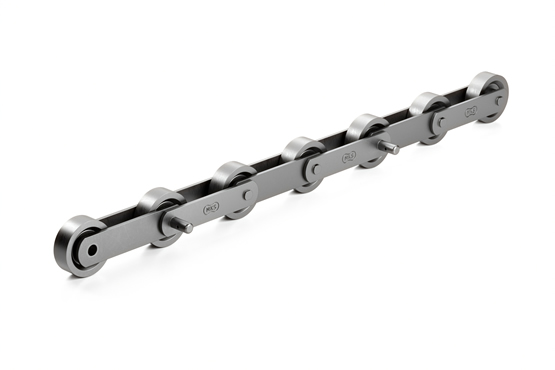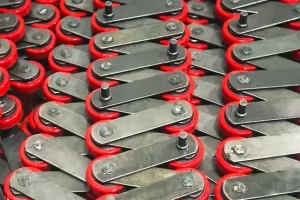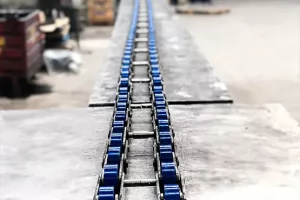
Wondering what is an escalator chain? Then, you’re in the right place! Step chains, also known as escalator chain types, are what move the steps on escalators and drive moving sidewalks. The steps are installed about every 400 millimeters, however, widths and heights are different. If you want to learn more about these chains, keep on reading!
 How do escalator chains work?
How do escalator chains work?
A step chain works via a gear train between the step and links on the chain. The pitch of the chain determines how many steps are carried by each gear. Escalator chains are typically mounted on the steps of the escalator and can either be of steel or aluminum. They work just like a regular chain but have several differences that make their design more effective.
Steps installed on chains are generally easier to adjust than steps attached to columns. However, step shafts with square corners can be difficult to adjust in some cases. The fact that the chain plate radius is small makes it easier to deform when you turn an extended pin. Therefore, you might need to move the chain plate to put enough force onto it.
Moving walkway steps or treads are connected together by step chains which are entrained upon and driven by powered sprockets to move the steps or treads along their path of travel. The step chains are provided with rollers that move along tracks defining the path of travel of the steps. In one prior art system, the step chain roller tracks are provided with a vertical sidewall that engages the sides of the step chain rollers. This trackside wall is operable to guide and control lateral deflection of the step chain whereby the moving walkway steps have their lateral position controlled. In this way, gaps between the escalator steps and the balustrade skirts which flank the steps are controlled.
The roller tracks may be provided with a plurality of horizontal ridges, each ridge corresponding to a position along its length so that when such track is in use as an escalator supporting device having a plurality of elevators (such as stairways), each elevator has its own corresponding track so that each elevator can be moved on its own independently from any other elevator while still being supported by its corresponding track wherein said the track has raised portions so as to support said elevators during movement thereof thereon.
The Features of Escalator Chains

Step chains are a great option for your business because they hold up better and won’t wear down as quickly when compared to other types of chains. They’re also easier to install since they don’t require any extra hardware—just a special tool. The most common industries that these chains are used are construction sites and warehouses. Some types of step chains can even be used on commercial vehicles like buses and trucks. There are several features that make this type of chain more durable than regular roller chains:
– The pin diameter is larger than standard chains. This makes it harder for the nuts to come loose when you tighten them down on the other side of the chain.
– Length from step to step and from chain to chain is strictly controlled by manufacturers so that everything stays aligned properly.
As a leading global manufacturer of chains, Makelsan Chain offers a range of escalator chains. Subways, high-speed trains, airports and shopping malls where moving walkway steps are widely used are also places where step chains are common. These chains are made up of specially manufactured materials such as stainless steel and corrosion-resistant materials like Inconel etc.
Take a look at the product feature, explore our offers, and improve your systems with our advanced escalator chain technology from the “MAKELSAN CUSTOM MADE CHAINS CATALOG” for more detailed information!
ESCALATOR CHAINS
Escalator Chains FAQ
Weight, the diameter of the chain links, the number of steps or steps per second on each side, the length of steps, and the inclination angle are some of the factors that will help you decide if the chain can be durable against heavy loads. The flexible strength of step chains varies from 6 to 30 tons. The 9-ton type and 15-ton type are the most common. However, there are several models and types of machines geared for particular places or according to the needs and necessities of the clients.
The main advantage of using a step chain for heavy loads is its flexibility. It can be designed according to a customer’s needs and requirements by changing some parameters such as the number of steps per second and length of steps. In addition, it can be made stronger by increasing the number of steps per second or adding more links between two adjacent steps.
The maintenance of moving walkways and escalator chains with that is a complex task that requires expertise. They are used intensively all year round, under a wide range of operating conditions, with equipment that is subject to corrosion and deterioration. For example, the winter months can be particularly challenging for machineries such as escalators and moving walkways, as this climate causes the equipment to deteriorate quickly. In addition, sea air means that the equipment is exposed to corrosive elements such as salt water and sand which can cause corrosion of metal parts.
In order to overcome these challenges, special maintenance techniques must be employed by professionals who have adequate experience in this field. Lubrication of the chain must be applied carefully and regularly. There are two types of automatic lubrication, the first is the special oil that is supplied with the chains and the second is by using a special system.
Escalator chains can be used in wet or humid environments. However, they might need extra applications to operate in outdoor conditions. Semi-outdoor step chains have extra options compared to regular chains working under normal operation indoors. Wet or humid environments do not affect the performance of an escalator in any way. The grooves in the steps remain flexible and will not get stuck in wet conditions.

 How do escalator chains work?
How do escalator chains work?
